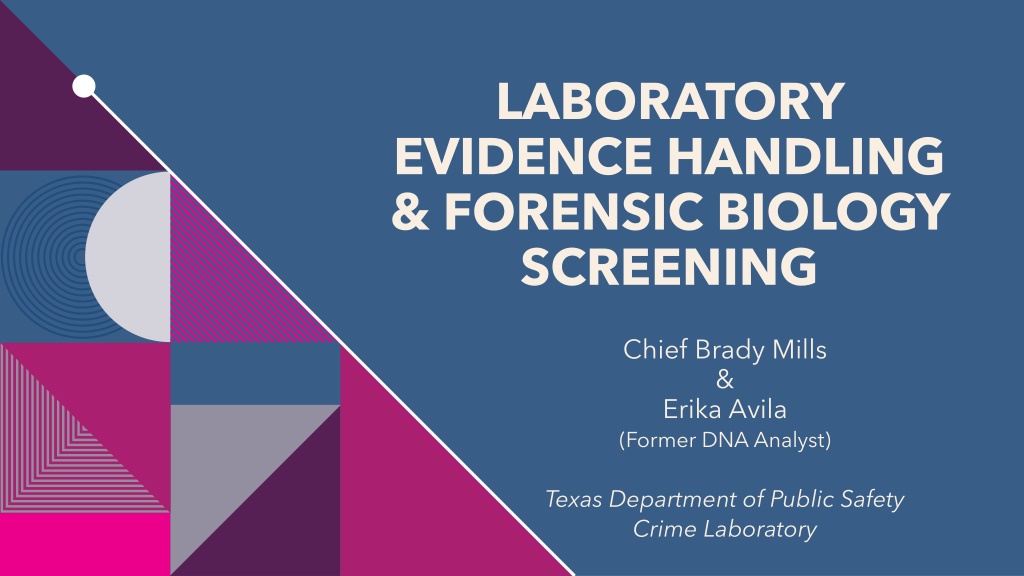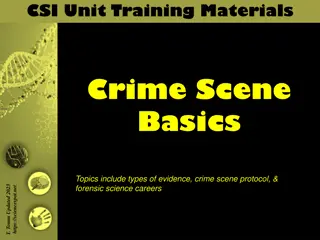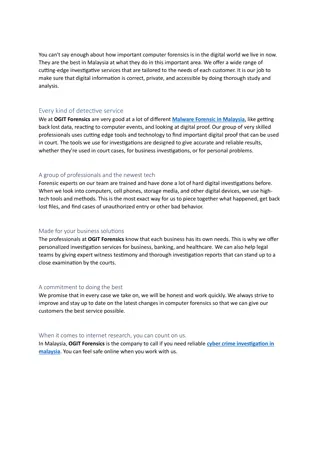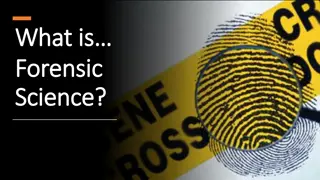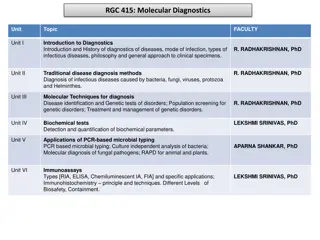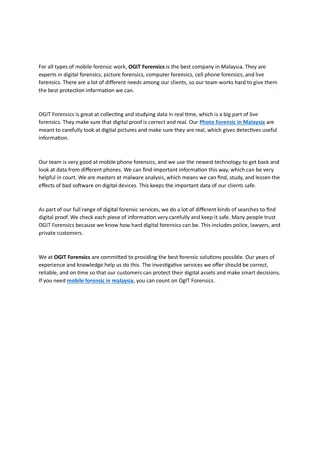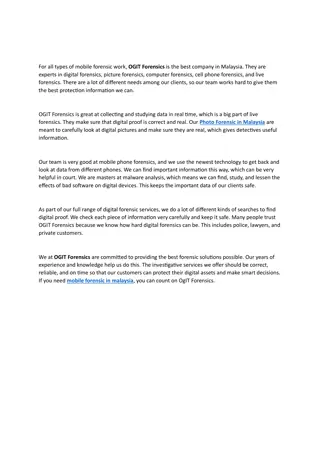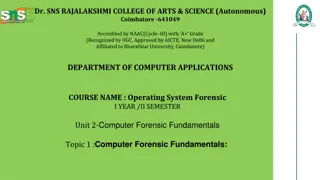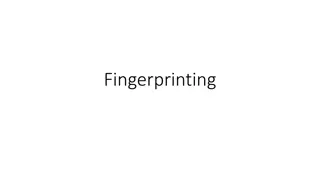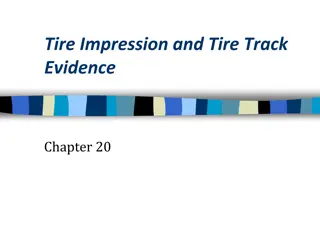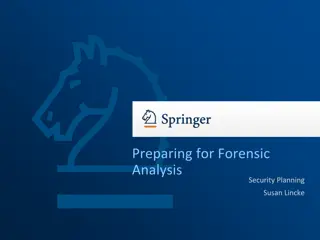Laboratory Evidence Handling & Forensic Biology Screening Overview
This document provides information on the case acceptance policy, evidence handling practices, and forensic serology screening procedures at the Texas Department of Public Safety Crime Laboratory. It outlines the limitations and guidelines for DNA testing, types of evidence accepted, and the number of items accepted based on the offense type.
Download Presentation

Please find below an Image/Link to download the presentation.
The content on the website is provided AS IS for your information and personal use only. It may not be sold, licensed, or shared on other websites without obtaining consent from the author. Download presentation by click this link. If you encounter any issues during the download, it is possible that the publisher has removed the file from their server.
E N D
Presentation Transcript
LABORATORY EVIDENCE HANDLING & FORENSIC BIOLOGY SCREENING Chief Brady Mills & Erika Avila (Former DNA Analyst) Texas Department of Public Safety Crime Laboratory
OVERVIEW Biology/DNA Case Acceptance Policy Evidence Handling Practices Forensic Serology Screening
CASE ACCEPTANCE POLICY BIOLOGY/DNA ANALYSIS CUSTOMER HANDBOOK A. For all case submissions, the number of items or samples that are tested is limited to the minimum number necessary to answer the relevant questions in the case. B. The Laboratory does not accept and/or perform DNA testing on: Paternity cases Any evidence from seized drug offenses Items submitted in possession offense cases involving firearms C. Touch* DNA is DNA from items which are suspected to not have biological fluids, but are collected in an effort to obtain DNA from skin cells. Requests for touch DNA analysis on items recovered from property crimes will not generally be accepted by the laboratory. Requests for touch DNA analysis on items recovered from violent crimes may be accepted on a case-by-case basis. Consultation with the laboratory prior to submission is recommended. In general, the Laboratory does not analyze items where there has been a minimal amount of contact involved (e.g. contact with steering wheels, shift knobs, door handles, switches, countertops, keys, locks, ammunition, cartridge cases, friction ridge impressions, etc.).
CASE ACCEPTANCE POLICY BIOLOGY/DNA ANALYSIS CUSTOMER HANDBOOK D. Hair evidence submitted for DNA analysis is examined in consultation with a Trace Evidence analyst prior to DNA processing. E. In general, the Laboratory does not perform Biology/DNA analysis on fecal/stool samples or vomit samples. F. Negative sexual assault kit with preserved trace evidence is forwarded to the Trace Evidence Section for analysis. G. Suspect known reference samples submitted are not processed for entry into CODIS IF: They were submitted without associated evidence Screening results have been released and no evidentiary samples will be analyzed for DNA; or DNA analysis results have been released and no further comparisons are necessary. H. The type and number of items or samples that are accepted for analysis is based on the type of offense Known/reference samples do not count against the number of items that may be submitted
CASE ACCEPTANCE POLICY NUMBER OF ITEMS ACCEPTED BASED ON TYPE OF OFFENSE 1. Burglary or Property Crime Related Offenses Submission is limited to 2 items More than 2 items may be accepted if the circumstances dictate the need for additional analysis (such as multiple perpetrators) 2. Sexual Assault Related Offenses Initial submission is limited to the sexual assault kit, 1 pair of underwear, & a condom Up to 2 additional items which have been determined by the customer to be most probative may also be submitted after prior consultation & approval by laboratory. If analysis of the sexual assault evidence collection kit is negative, a second submission of up to 5 items, such as clothing or bedding, may be accepted. If no sexual assault evidence collection kit was collected, submission of items such as clothing, bedding, or requests for Touch DNA analysis may be accepted during the first submission. Consultation with the Laboratory prior to submission is recommended.
CASE ACCEPTANCE POLICY NUMBER OF ITEMS ACCEPTED BASED ON TYPE OF OFFENSE 3. Homicide Related Offenses Initial submission = 10 items for which the customer believes analysis will be most informative If no informative results are obtained from the analysis in the first submission, a second submission of 10 additional items may be accepted A written request from the Prosecutor, including sufficient justification, must be received by the Laboratory before any decisions on performing additional testing are considered once informative results have been obtained. Additional samples are not tested to merely disprove all possible scenarios 4. Crimes Against Persons Related Offenses Submission is limited to 5 items The type of evidence, how the evidence may have been used/handled, and the duration of the use/handling is considered when determining if the evidence will be processed for DNA analysis.
LIFE AFTER SUBMISSION WHAT HAPPENS ONCE EVIDENCE ENTERS THE LAB? Goal To prevent evidence loss, damage, and contamination while maintaining a proper chain of custody 1. 2. 3. 4. 5. Evidence gets accepted by the evidence receiving team Evidence gets stored in a location with limited access Analyst takes possession of the evidence Analyst performs serology screening on evidence Evidence gets returned
EVIDENCE HANDLING BEST PRACTICES During submission Evidence receiving (ER) team ensures packaging is intact, proper seal, & storage requirements based on evidence type During screening Proper PPE Only 1 item of evidence open at a time Clean lab bench & tools between items Ensure proper storage conditions
SEROLOGY SCREENING Analytical Approaches to Body Fluid Identification 1. Blood Examinations a) Visual examination b) Preserve trace evidence when appropriate c) Presumptive testing d) Preserve the stain, cutting or swab e) Test for other body fluids if indicated 2. Semen Examinations a) Visual examination b) Preserve trace evidence when appropriate c) Alternate Light Source (ALS) tool d) Presumptive testing e) Confirmatory testing f) Preserve the stain, cutting or swab g) Male screening can be used as an alternative
SEROLOGY SCREENING Can an analyst stop screening? How far the analyst proceeds in a particular case will depend on the available sample and on what is necessary to answer the question(s) posed Example: once semen is confirmed on at least 1 item it is not necessary to examine other items unless circumstances dictate the need for additional analysis (e.g. multiple assailants and/or consensual sex partner(s)) Tools used in Serology: Male screening Alternate Light Source (ALS) Scalpel blades, tweezers, sharpies, envelopes, tape, sterile tubes, swabs, bench paper
IMPACT OF EVIDENCE COLLECTION & HANDLING IRREGULARITIES Collection/handling of evidence (prior to submission) Contamination No gloves/mask Packaging evidence together (cross-contamination) Degradation Packaging evidence in non-breathable containers Not allowing wet items to fully airdry Improper storage Evidence loss/switch Labeling packaging Handling of evidence within the laboratory Contamination Degradation Sample switching
RECOMMENDATION FROM THE TEXAS FORENSIC SCIENCE COMMISSION TX DPS Records Program has developed minimum requirements for a typical litigation packet in order to ensure that all customers are receiving consistent information. The litigation packet is sent upon receipt of a subpoena In the works records portal (Tex. Gov't. Code 411.162)
